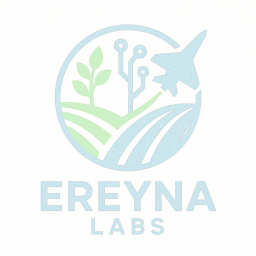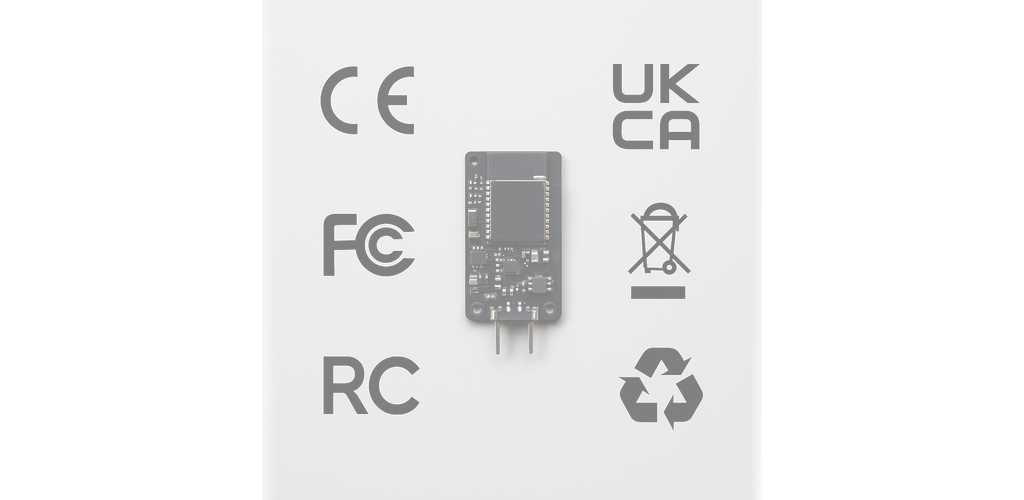As the demand for smart agriculture and environmental monitoring technology continues to rise, launching an IoT device that measures soil quality, NPK (Nitrogen, Phosphorus, and Potassium), moisture, and acidity represents a significant opportunity. However, entering retail markets across regions such as the UK, EU, and USA requires navigating a detailed and sometimes challenging regulatory environment. Compliance is not only mandatory but also a hallmark of quality, safety, and consumer trust.
This comprehensive guide outlines the necessary certifications and compliance steps we took to legally and successfully bring our soil monitoring IoT device to the market. From electromagnetic compatibility testing to battery recycling schemes, we will cover everything you will need to know when considering a similar device to market strategy.
🇬🇧 United Kingdom (UK) Compliance
UKCA Marking
Since Brexit, the UKCA (UK Conformity Assessed) mark has replaced the CE mark for products placed on the British market. It is a self-declaration system in most cases, covering regulations for:
- Electromagnetic Compatibility (EMC)
- Radio Equipment
- Restriction of Hazardous Substances (RoHS)
Key Considerations:
- Required for all electronics sold in England, Scotland, and Wales.
- Northern Ireland may still use CE marking under the NI Protocol.
- Technical documentation must be retained for at least 10 years.
Estimated Cost: £2,000 to £8,000, depending on whether third-party testing is required.
EMC & Radio Testing
Devices must comply with UK regulations for electromagnetic emissions and immunity. Testing must be performed by an accredited lab if you opt for third-party validation. Radio testing for BLE, WiFi, and LORA ensures the device operates within permitted frequency ranges and power limits.
Battery and WEEE Compliance
The device’s use of a lithium battery and solar charging necessitates:
- Registration with the UK Environment Agency as a battery producer.
- Membership in a WEEE compliance scheme for e-waste collection and recycling.
- Proper labeling for battery safety and disposal.
Annual Costs: Generally range between £300 and £1,000.
PSTI Compliance
The Product Security and Telecommunications Infrastructure (PSTI) Act mandates:
- Unique and non-default passwords.
- A policy for managing security vulnerabilities.
- Regular security updates.
These requirements are expected to evolve and expand, so keeping firmware and documentation up to date is crucial.
🇪🇺 European Union (EU) Compliance
CE Marking
A CE mark is legally required for most electronics sold in the EU. It demonstrates conformity with multiple EU directives:
- EMC Directive (2014/30/EU): Controls emissions and immunity.
- Radio Equipment Directive (RED) (2014/53/EU): Ensures safety and spectrum efficiency for wireless devices.
- RoHS Directive (2011/65/EU): Limits harmful substances in electrical and electronic equipment.
- Battery Directive (2006/66/EC): Requires safe battery use and disposal.
- WEEE Directive (2012/19/EU): Enforces proper e-waste management.
Cost Estimate: €5,000 to €15,000 depending on lab testing and use of modular certifications.
Environmental Compliance
In addition to CE, your device must meet several environmental regulations:
- Register as a battery producer.
- Label and provide take-back for used batteries.
- Register with a national WEEE compliance scheme in each country of sale.
- Submit annual reports for market surveillance and waste management purposes.
GDPR Considerations
If your device collects or processes personal data (e.g., location, usage habits), it must comply with the General Data Protection Regulation (GDPR). This includes:
- Data minimization and encryption.
- User consent and transparent privacy policies.
- Designation of a data controller.
Fines for non-compliance can be severe, so it’s recommended to consult legal experts when designing your cloud services.
🇺🇸 United States (USA) Compliance
FCC Certification
The Federal Communications Commission (FCC) regulates all devices that use radio frequency in the U.S. market. For BLE, WiFi, and LORA modules, you must comply with:
- Part 15 Subpart C for intentional radiators
- RF exposure and SAR limits
Using pre-certified modules may simplify this process but still requires correct labeling and device integration review.
Estimated Cost: $8,000 to $15,000, including lab tests and documentation filing.
UL/ETL Safety Testing
Though not federally required, UL or ETL certification is critical for acceptance by major distributors and retailers. Applicable standard:
- UL 62368-1: Covers safety of AV, IT, and communication equipment.
Estimated Cost: $10,000 to $20,000+, plus factory inspections.
UN38.3 Battery Test
To legally ship lithium batteries, compliance with UN38.3 is required. This test simulates:
- Thermal, shock, vibration, and altitude conditions.
- Short-circuit and overcharge scenarios.
Cost: $3,000 to $5,000 per battery variant.
State-Level Regulations
California’s Prop 65 law may require warnings if your product contains chemicals known to cause cancer or reproductive harm. Material disclosures and packaging labels must be managed carefully.
🇦🇹 Asia and Middle East Compliance
Compliance requirements in Asia and the Middle East vary significantly by country. However, there are recurring themes involving radio frequency licensing, product safety, environmental regulations, and labeling. Here’s a breakdown of common requirements in major markets:
🇸🇬 Singapore
- IMDA Certification: Devices using RF (WiFi, BLE, LORA) must be certified by the Infocomm Media Development Authority.
- RoHS & Safety: IEC standards apply for electrical safety and substance restrictions.
- Cost Estimate: SGD 2,000–5,000
- Timeline: 3–6 weeks
🇮🇳 India
- WPC Approval: Required for all wireless communication devices.
- BIS Certification: Bureau of Indian Standards may require safety approvals for the power supply.
- E-Waste Compliance: Registration under the E-Waste (Management) Rules.
- Cost Estimate: ₹150,000–₹300,000
- Timeline: 6–12 weeks
🇦🇪 United Arab Emirates (UAE)
- TRA Approval: The Telecommunications and Digital Government Regulatory Authority mandates RF certification.
- ESMA Registration: Electrical safety certification via Emirates Authority for Standardization and Metrology.
- Cost Estimate: AED 10,000–25,000
- Timeline: 4–8 weeks
🇯🇵 Japan
- MIC Certification: Radio frequency and telecommunications equipment must be certified by the Ministry of Internal Affairs and Communications.
- PSE Mark: Electrical safety approval for battery-powered and plug-in devices.
- Cost Estimate: ¥300,000–¥800,000
- Timeline: 6–10 weeks
General Best Practices for Asia/Middle East:
- Use local representatives or importers to navigate language and bureaucratic challenges.
- Label all devices in local languages if required.
- Confirm local recycling, take-back schemes, or packaging requirements where applicable.
📊 Cross-Market Best Practices
Use Pre-Certified Radio Modules
Selecting BLE/WiFi/LORA modules that already hold FCC/CE/UKCA certification reduces the need for full RF testing and speeds up time to market.
Proper Labeling and Documentation
Mandatory elements across all markets include:
- Certification marks (CE, FCC ID, UKCA)
- Frequency bands and power ratings
- Battery warnings and recycling logos
- Manufacturer/importer contact details
Cybersecurity Readiness
With evolving laws, your device should be equipped with:
- Secure boot and encrypted firmware
- Password policies and access controls
- OTA (Over-the-Air) update capability
📅 Compliance Checklist Summary
Ensure you manage each of the following by region:
- EMC, radio, and safety testing
- Battery and environmental registrations
- Product markings and labeling
- Legal documentation and retention
- Cybersecurity and data protection compliance
A detailed Excel-based compliance tracker is invaluable for managing timelines, costs, and responsibilities across departments.
💰 Estimated Costs
Estimated Compliance Costs by Region:
| Region | Certification & Testing | Estimated Cost (Low) | Estimated Cost (High) |
|---|---|---|---|
| UK | UKCA, EMC, Radio, RoHS, PSTI, Battery, WEEE | £2,500 | £10,000 |
| EU | CE, EMC, RED, RoHS, Battery, WEEE, GDPR | €5,000 | €15,000 |
| USA | FCC, UL/ETL, UN38.3, Prop 65 | $15,000 | $30,000 |
| Asia | IMDA, WPC, MIC, ESMA, BIS, E-Waste | $2,000 | $10,000 |
| Middle East | TRA, ESMA, local radio & safety | $3,000 | $8,000 |
Time Estimates by Activity:
| Activity | Estimated Duration |
| Pre-certification Planning | 2–3 weeks |
| Module Selection & Design Finalization | 2–4 weeks |
| EMC/Radio Testing | 3–6 weeks |
| Safety and Battery Testing | 4–8 weeks |
| Documentation & Marking Preparation | 2–3 weeks |
| Registration (WEEE, Battery, etc.) | 1–2 weeks per region |
Total Compliance Timeline: Approximately 3 to 4 months (can be shorter if processes run in parallel).
Keep in mind that using pre-certified modules, experienced labs, and proactive documentation can significantly reduce both time and cost.
🎓 Recommended Labs & Consultants
Global Test Labs
- TÜV Rheinland: Compliance partner for CE, FCC, UKCA.
- SGS: Broad global reach, from battery testing to EMC.
- Eurofins E&E: EU-focused testing and documentation services.
- Intertek (ETL): North America and global compliance.
- UL: Safety testing, UL Mark, and factory audits.
Regulatory Consultants
- CE Marking Association (UK): Regulatory support and documentation help.
- Obelis Group (EU): Acts as your EU Authorized Representative.
- ProductIP: SaaS platform and services for EU product compliance.
🏥 Medical Device Compliance & Regulations
Compliance for medical IoT devices is significantly more rigorous and costly than for general consumer electronics due to the involvement of health data, patient safety, and clinical functionality. In the EU, medical IoT devices must conform to the Medical Device Regulation (MDR 2017/745), which classifies devices based on risk and mandates conformity assessment by a Notified Body for most products. Additionally, CE marking still applies for aspects such as EMC, radio (RED), and RoHS compliance. For cybersecurity and data protection, the General Data Protection Regulation (GDPR) is also strictly enforced, particularly for devices that collect or transmit patient data. In the UK, similar requirements exist under the UK Medical Devices Regulations 2002 (as amended), along with the need for UKCA marking and compliance with PSTI cybersecurity provisions. For the USA, devices must receive FDA clearance or approval, typically via a 510(k) submission, De Novo classification, or PMA (Premarket Approval) process, depending on the device’s risk class. Additionally, devices must meet FCC requirements for radio emissions and may require UL safety certification for electronic hardware.
The costs for medical IoT compliance can range significantly. Initial regulatory strategy and classification can cost $10,000–$25,000, followed by $50,000–$250,000+ for clinical testing, quality system implementation (ISO 13485), FDA/CE/UKCA submissions, and lab testing. If a device includes wireless communication, expect to budget another $10,000–$30,000 for FCC, RED, or UKCA radio module testing. The entire compliance process typically spans 6 to 18 months, depending on device complexity and regulatory pathways.
💰 Estimated Costs
Estimated Compliance Costs by Region:
| Region | Certification & Testing | Estimated Cost (Low) | Estimated Cost (High) |
|---|---|---|---|
| UK | UK MDR, UKCA, PSTI, ISO 13485 | £50,000 | £160,000 |
| EU | MDR, CE, RED, RoHS, GDPR, ISO 13485 | €70,000 | €230,000 |
| USA | FDA 510(k)/De Novo/PMA, FCC, UL, HIPAA | $100,000 | $300,000 |
| Asia | IMDA, WPC, MIC, PSE, BIS, ISO 13485 | $50,000 | $150,000 |
| Middle East | TRA, ESMA, ISO 13485 | $40,000 | $120,000 |
🚀 Final Thoughts
Product compliance is both a technical and legal requirement that ensures safety, reliability, and access to key markets. Though the landscape may appear complex, leveraging certified components, engaging experienced labs, and maintaining meticulous records can significantly streamline the process.
Whether you’re launching your first IoT device or scaling your portfolio, early planning for compliance saves time, reduces risk, and builds consumer confidence. If you need help with lab selection, compliance road map creation, or even hands-on testing coordination, reach out—we’re here to help.

